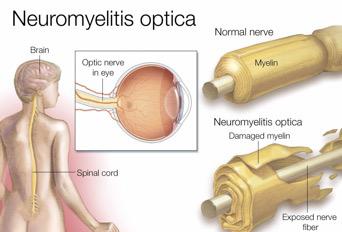What is Neuromyelitis Optic?
Neuromyelitis optica (NMO) is an autoimmune disease that mainly attacks optic nerves and spinal cord and can also damage the brain. It is regarded as the Devic’s disease, and is also an auto-immune disease. NMO is a disease that is relapsing-remitting. During a recovery, new damage can lead to accumulation of disability of the optic nerves and/or spinal cord. A particular attack on the aquaporin-4 (AQP4) water channel situated inside the optic nerves and spinal cord is suspected to be the consequence of NMO. Aquaporins (AQPs) are proteins that carry water through the membranes of cells.
What are the symptoms leading to doctor’s recommending – Neuromyelitis Optic?
- Weakness
- Blindness in eyes
- Paralysis in the legs
- Problems with bladder and bowel function
- Swelling
- Pain
- Loss of function
- Uncontrollable nausea
- Vomiting
Evaluations for Neuromyelitis Optic
- Blood tests
- MRI
- Spinal tap
- Evoked potentials
- Ophthalmology
- Neurological examination
Treatment for Neuromyelitis Optic
There is no NMO cure, but treatments can aid certain symptoms and the frequency and intensity of relapses. Steroids such as injected methylprednisone may be prescribed by a doctor. After the injection, the patient will take oral steroids. Plasma exchange or plasmapheresis treatment is generally provided to patient with NMO who had not reacted to steroid treatment. Plasma Exchange prevents antibodies causing inflammation from the blood. It removes the blood and separates the blood cells from plasma. Blood cells are transferred to the bloodstream, diluted with fresh plasma or substitutes. The possibility of relapses are considerably decreased when the immune system of the patient is suppressed. Medicines to suppress immune activity are often prescribed with the prescription of azathioprine (AZT). A combination of AZT and steroid can be prescribed by the doctor.










